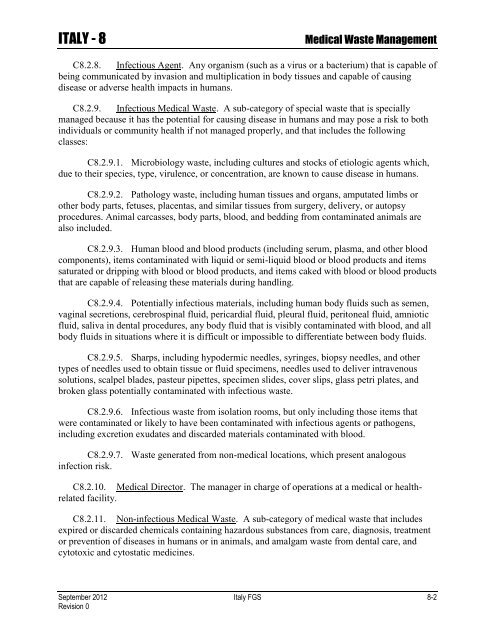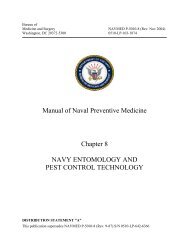ENVIRONMENTAL FINAL GOVERNING STANDARDS ITALY
ENVIRONMENTAL FINAL GOVERNING STANDARDS ITALY
ENVIRONMENTAL FINAL GOVERNING STANDARDS ITALY
Create successful ePaper yourself
Turn your PDF publications into a flip-book with our unique Google optimized e-Paper software.
<strong>ITALY</strong> - 8 Medical Waste Management<br />
C8.2.8. Infectious Agent. Any organism (such as a virus or a bacterium) that is capable of<br />
being communicated by invasion and multiplication in body tissues and capable of causing<br />
disease or adverse health impacts in humans.<br />
C8.2.9. Infectious Medical Waste. A sub-category of special waste that is specially<br />
managed because it has the potential for causing disease in humans and may pose a risk to both<br />
individuals or community health if not managed properly, and that includes the following<br />
classes:<br />
C8.2.9.1. Microbiology waste, including cultures and stocks of etiologic agents which,<br />
due to their species, type, virulence, or concentration, are known to cause disease in humans.<br />
C8.2.9.2. Pathology waste, including human tissues and organs, amputated limbs or<br />
other body parts, fetuses, placentas, and similar tissues from surgery, delivery, or autopsy<br />
procedures. Animal carcasses, body parts, blood, and bedding from contaminated animals are<br />
also included.<br />
C8.2.9.3. Human blood and blood products (including serum, plasma, and other blood<br />
components), items contaminated with liquid or semi-liquid blood or blood products and items<br />
saturated or dripping with blood or blood products, and items caked with blood or blood products<br />
that are capable of releasing these materials during handling.<br />
C8.2.9.4. Potentially infectious materials, including human body fluids such as semen,<br />
vaginal secretions, cerebrospinal fluid, pericardial fluid, pleural fluid, peritoneal fluid, amniotic<br />
fluid, saliva in dental procedures, any body fluid that is visibly contaminated with blood, and all<br />
body fluids in situations where it is difficult or impossible to differentiate between body fluids.<br />
C8.2.9.5. Sharps, including hypodermic needles, syringes, biopsy needles, and other<br />
types of needles used to obtain tissue or fluid specimens, needles used to deliver intravenous<br />
solutions, scalpel blades, pasteur pipettes, specimen slides, cover slips, glass petri plates, and<br />
broken glass potentially contaminated with infectious waste.<br />
C8.2.9.6. Infectious waste from isolation rooms, but only including those items that<br />
were contaminated or likely to have been contaminated with infectious agents or pathogens,<br />
including excretion exudates and discarded materials contaminated with blood.<br />
C8.2.9.7. Waste generated from non-medical locations, which present analogous<br />
infection risk.<br />
C8.2.10. Medical Director. The manager in charge of operations at a medical or healthrelated<br />
facility.<br />
C8.2.11. Non-infectious Medical Waste. A sub-category of medical waste that includes<br />
expired or discarded chemicals containing hazardous substances from care, diagnosis, treatment<br />
or prevention of diseases in humans or in animals, and amalgam waste from dental care, and<br />
cytotoxic and cytostatic medicines.<br />
September 2012 Italy FGS 8-2<br />
Revision 0
















